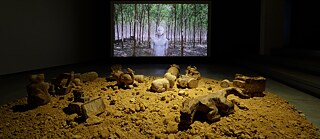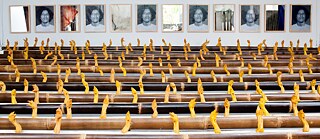THE GIFT, presented by Singapore Art Museum, Singapore
The Gift draws upon the project’s broader themes of interwoven histories, performed narratives and embodiment. Exemplified by Korean American artist Nam June Paik’s first meeting with German artist Joseph Beuys and the powerful feeling of being deeply moved by each other, SAM’s exhibition focuses on the nature of relations, affinities and influences, wherein history, geography and identity are observed as manifestations of such entanglement.
Presenting artworks and historical materials from the collections of SAM and partner institutions Galeri Nasional Indonesia, MAIIAM Contemporary Art Museum, and Nationalgalerie – Staatliche Museen zu Berlin, The Gift invites visitors to consider a multi-dimensional view of artworks and materials from across geographies and their relation to one another. Bringing visitors through a complex journey, the exhibits are presented as intimately connected through narratives, agencies, and histories, inspiring new meanings and perspectives.
Energiestab (Energy Staff) (1974) by Joseph Beuys embodies key aspects of the artist’s influential practice, particularly his ideal of Eurasia as an expanded frame which defies the boundaries that delineates cultures and aesthetics. Salleh Japar’s Born out of Fire (1993) was inspired by Japar’s travels to Australia and draws on universal symbols that are familiar across cultures and belief systems, yet personal when read within the context of one’s daily life. Tang Da Wu’s Monument for Seub Nakhasathien (1991) extends support to Thai conservationist Seub Nakhasathien and his cause, continuing Tang’s explorations into issues of environment and ecology.
The Gift also investigates the nature of exchanges – of their gesture, value, expectations and reciprocation – and how the status and interpretation of exchange may also change over time. Donna Ong’s The Caretaker (2008) for instance, extends the history of the Friendship Doll Project of 1927, an exchange of dolls between Japan and the United States as a symbol of goodwill and their close relationship. Many of the dolls were destroyed when tensions between the two countries escalated during World War II. Ong’s work returns to this historical moment by creating a fictional setting where a caretaker appears to be watching over the memory of the dolls and bearing witness to their amicable reunion.
Unpacking the complex definition of territories in Southeast Asia, Ho Tzu Nyen presents The Critical Dictionary of Southeast Asia: F for Fold (2021), from an ongoing project that is one of the commissioned works for Collecting Entanglements and Embodied Histories, where he showcases an amorphous interpretation of the subject of historical narratives through an endless physical book.
Beyond looking at historical landscapes and symbols, The Gift also draws visitors into introspective consideration of the self, through works that reflect personal expressions of interrelations between bodies and spaces, sensibilities and the other.
A key example is Bruce Nauman’s Korperdruck (Body Pressure) (1980), which invites audiences to introduce their body to the unyielding surface of a wall, encountering and becoming conscious of its resistance. Through this participatory work, Nauman encourages an examination of the self and one’s relationship with their own body. In Holly Zausner’s video work Second Breath (2004-2005), her performance enacted using large latex human-like forms set against a backdrop of Berlin’s architecture reflect her response to these historical structures, their narratives and the place of the individual in them.
The Gift is curated by June Yap, with Anna-Catharina Gebbers, Grace Samboh, and Gridthiya Gaweewong.
Energiestab (Energy Staff) (1974) by Joseph Beuys embodies key aspects of the artist’s influential practice, particularly his ideal of Eurasia as an expanded frame which defies the boundaries that delineates cultures and aesthetics. Salleh Japar’s Born out of Fire (1993) was inspired by Japar’s travels to Australia and draws on universal symbols that are familiar across cultures and belief systems, yet personal when read within the context of one’s daily life. Tang Da Wu’s Monument for Seub Nakhasathien (1991) extends support to Thai conservationist Seub Nakhasathien and his cause, continuing Tang’s explorations into issues of environment and ecology.
The Gift also investigates the nature of exchanges – of their gesture, value, expectations and reciprocation – and how the status and interpretation of exchange may also change over time. Donna Ong’s The Caretaker (2008) for instance, extends the history of the Friendship Doll Project of 1927, an exchange of dolls between Japan and the United States as a symbol of goodwill and their close relationship. Many of the dolls were destroyed when tensions between the two countries escalated during World War II. Ong’s work returns to this historical moment by creating a fictional setting where a caretaker appears to be watching over the memory of the dolls and bearing witness to their amicable reunion.
Unpacking the complex definition of territories in Southeast Asia, Ho Tzu Nyen presents The Critical Dictionary of Southeast Asia: F for Fold (2021), from an ongoing project that is one of the commissioned works for Collecting Entanglements and Embodied Histories, where he showcases an amorphous interpretation of the subject of historical narratives through an endless physical book.
Beyond looking at historical landscapes and symbols, The Gift also draws visitors into introspective consideration of the self, through works that reflect personal expressions of interrelations between bodies and spaces, sensibilities and the other.
A key example is Bruce Nauman’s Korperdruck (Body Pressure) (1980), which invites audiences to introduce their body to the unyielding surface of a wall, encountering and becoming conscious of its resistance. Through this participatory work, Nauman encourages an examination of the self and one’s relationship with their own body. In Holly Zausner’s video work Second Breath (2004-2005), her performance enacted using large latex human-like forms set against a backdrop of Berlin’s architecture reflect her response to these historical structures, their narratives and the place of the individual in them.
The Gift is curated by June Yap, with Anna-Catharina Gebbers, Grace Samboh, and Gridthiya Gaweewong.


